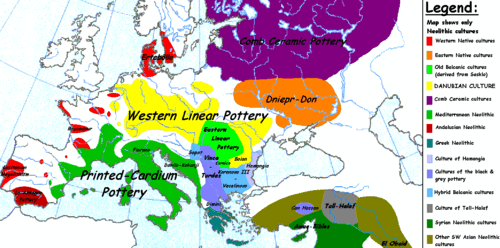- Bug-Dniester culture
-
Bug-Dniester culture, Dniester-Bug culture was the archaeological culture that developed in the chernozem region of Moldavia and Ukraine around the Dniester and Southern Bug rivers in the Neolithic.
Over approximately 1500 years, 6500-5000 BC, the culture metamorphosed into quite different phases, but the population remained about the same. What is most noteworthy about the Neolithic in this region is that it developed autochthonously from the Mesolithic there.
The earlier phases are pre-pottery. The people in this region reinvented the wheel, so to speak. They relied predominantly on hunting aurochs, red deer, roe deer and boar, and fishing for roach, eels and pike. Claims of early farming are not supported by archaeological evidence.
At about 5800 BC they began to make a native pottery, mainly jars, flat-bottomed or pointed-bottomed, decorated in patterns of wavy lines. Influence from the Starcevo struck the native culture changing it drastically. Pottery suddenly became like that of the Starcevo culture and the wild grass was abandoned in favor of einkorn, emmer and spelt, already popular in south Europe.
At some time after 5500 BC, the Starcevo lost its influence in favor of one from the LBK (Linear Pottery culture). LBK people probably did enter the region from the upper Dniester and overran it as far south as the lower Danube. The pottery became like the LBK. Native stone subterranean houses were replaced by long houses.
The LBK that overran this region was a specific phase. At around 5270 BC calibrated, at the most populous peak of the LBK, judging from the number of dates obtained as a rough guideline, the pottery in eastern Austria acquired a new decorative style, termed Notenkopfkeramik by its German discoverers. In English it means "Notehead Pottery." Notehead is a good English word also but a little obscure. Most use "musical note" to translate Notenkopf.
In this style the incised broken line, one or two incisions wide, replaces the convolute bands of the early LBK. The lines may wander, as did the convolute bands, forming square maeanders, or they may go around the pot in zig-zag motifs, resembling bars of music. At the intersection of every broken line is a double or single deep puncture, the "notehead." An unbroken but punctured ring of one or more lines circle(s) the top of the piece. The style appears to be a modification of the LBK bands.
The style quickly spread into Poland through Slovakia, where it found the Western Bug. Moving along this corridor, they entered Ukraine and Romania along the Dneister and Prut. It is not known further west.
This specific culture acquired a very dense population, which in later times became the Cucuteni-Trypillian culture. That culture in turn was the last to fall to the Indo-Europeans after prolonged resistance. The population density remained, descending into the Slavic formation region of prehistory and the common Slavic or pre-migration region of late ancient history.
External links
- (French) [1]
Categories:- Archaeological cultures
- Archaeology of Ukraine
- Archaeology of Moldova
- Archaeology of Romania
- Archaeological cultures in Romania
Wikimedia Foundation. 2010.

